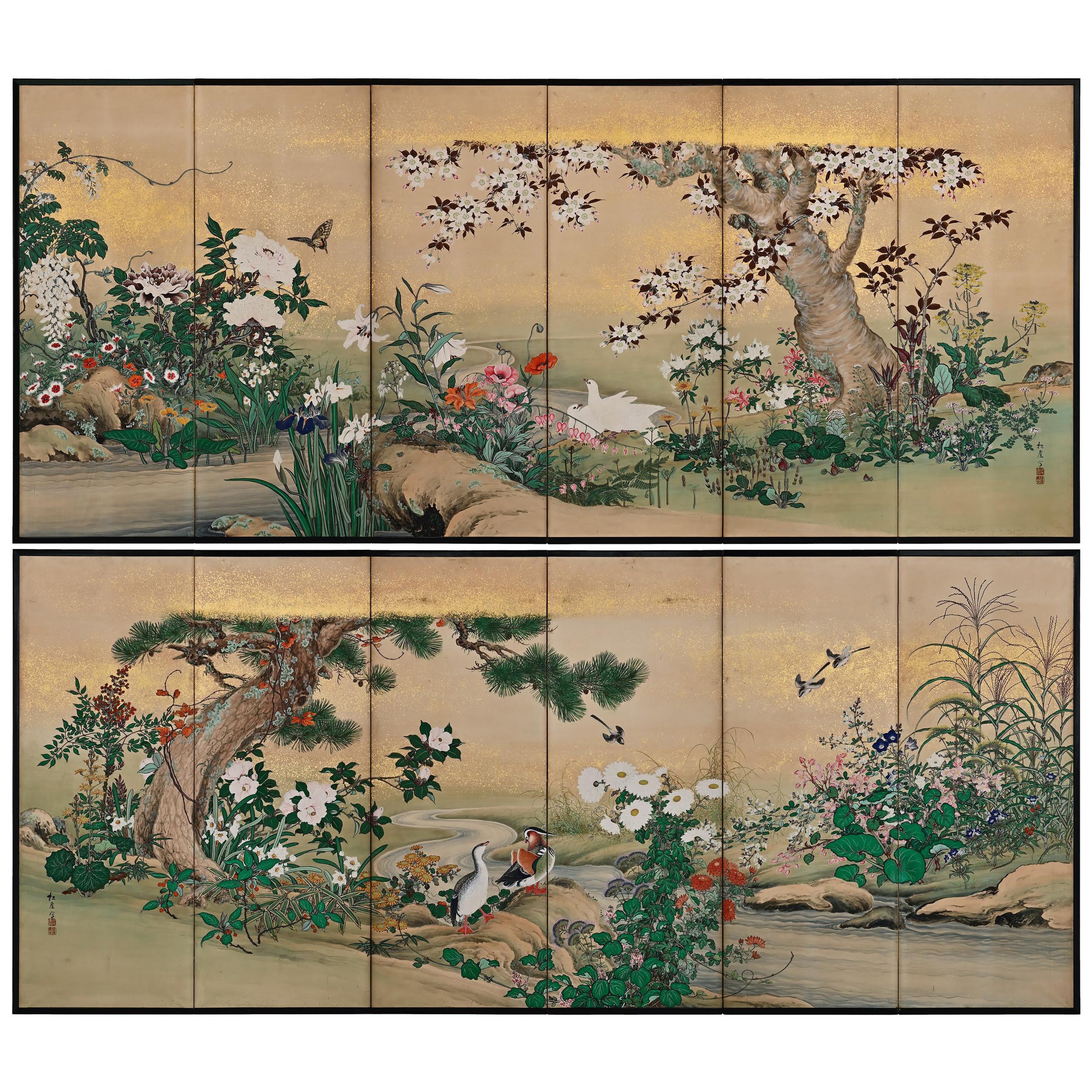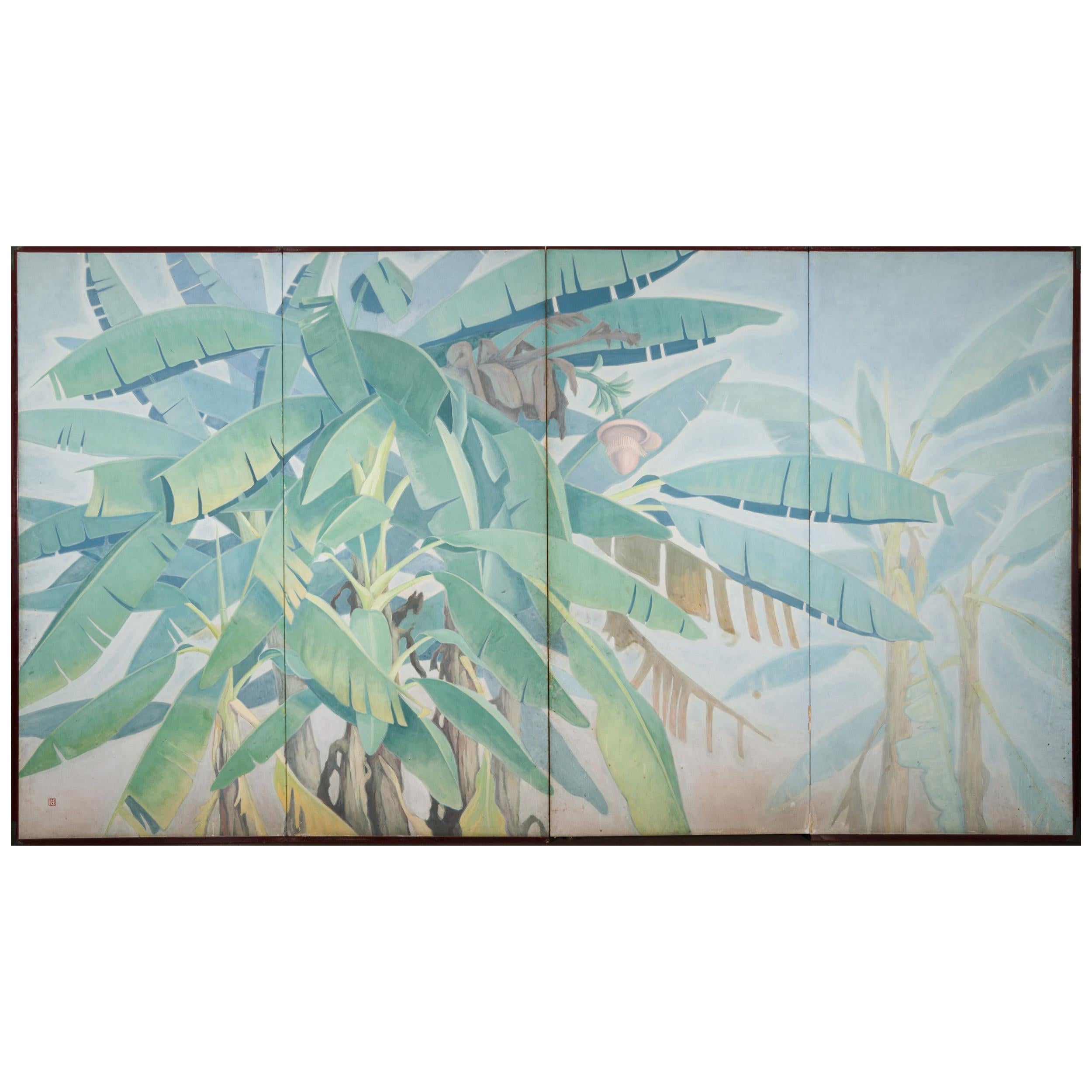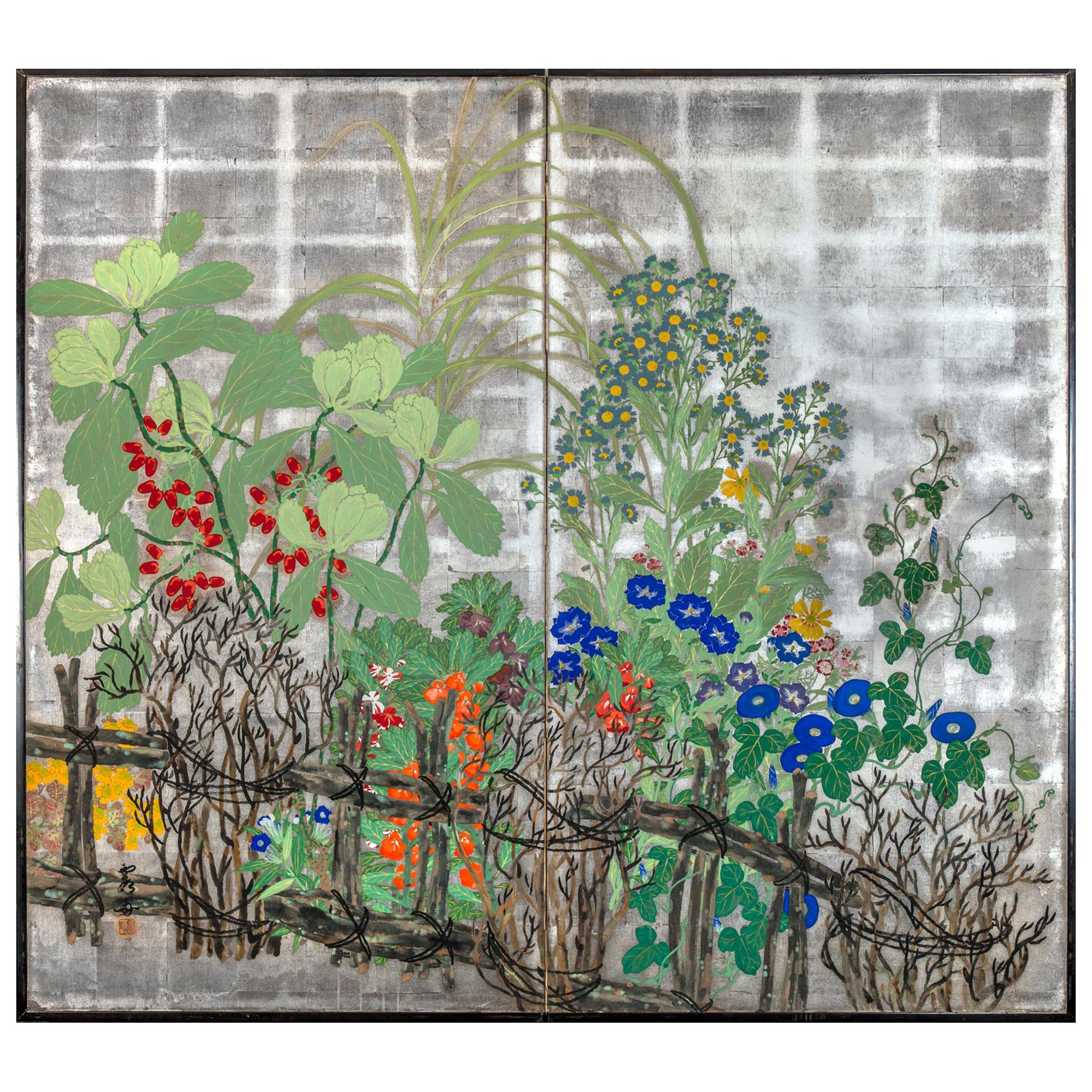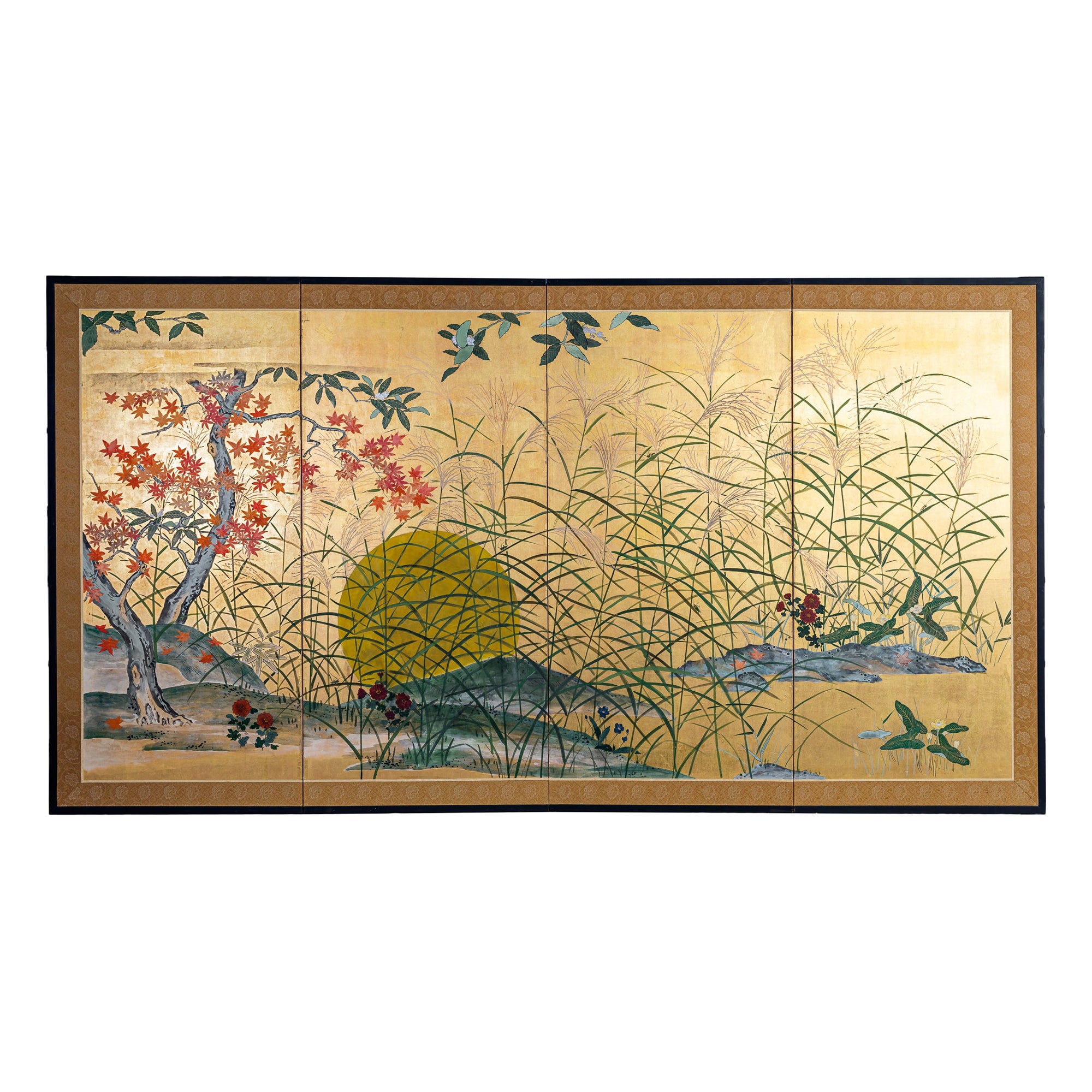Items Similar to circa 1930 Japanese Silver Screens by Isoi Joshin, Flowers of the Four Seasons
Want more images or videos?
Request additional images or videos from the seller
1 of 14
circa 1930 Japanese Silver Screens by Isoi Joshin, Flowers of the Four Seasons
About the Item
Flowers of the four seasons
Isoi Joshin (1883-1964)
Pair of six-panel Japanese screens
Ink, pigment, lacquer and silver leaf on paper
Inscription: Isoi Jo
Seal: Shin
Dimensions:
Each screen: : W. 379 cm x H. 175.5 cm (149” x 69”)
A distinctive Japanese artistic convention is to depict a single environment transitioning from spring to summer to autumn to winter in one painting. In this way, Japanese painters expressed not only their fondness for this natural cycle but also captured an awareness of the inevitability of change, a fundamental Buddhist concept. This pair of screens by Isoi Joshin celebrate not only the sensual appeal of elements of the natural world, but also imbue them with human emotions. Amongst a myriad of plants and flowers of varying degrees of recognizability are ferns, thistles, reeds and bush clover. Butterflies and dragonflies hover above them. The natural elements, being employed as decorative motifs, have been stylized to heighten the ornamental effect.
First and foremost a lacquer artist, Isoi Joshin has transferred these skills to the expansive silver-leaf canvas of this pair of six-fold screens. Along with traditional Japanese ink and pigments Joshin has also utilized lacquer in these paintings. This has led to some extraordinary colors which are unseen before in screen painting.
Born in Takamatsu, Isoi Joshin first studied lacquer arts at the Kagawa Prefectural Crafts School. After graduating in 1903 he moved to Osaka for a time to continue his studies. In 1904 he won a prize for a piece he exhibited at the St. Louis World Exposition. In 1909 he left the art dealer Yamanaka Company to return to Takamatsu where he founded his own studio. In 1916 he began teaching at the Kagawa Prefectural Crafts School. In 1919 and 1920 he exhibited at the Nitten. Again in 1929 he was accepted as an exhibitor at the 10th Teiten. Subsequently he exhibited annually at the Teiten, the Shin-Bunten and Hoshukuten national art exhibitions until the War. After the War he returned to the government sponsored exhibitions with the Nitten in 1946 at which he continued to exhibit until 1956. That year Joshin was designated an important intangible cultural property (commonly known as a Living National Treasure) for his skill at kimma or fine line decoration. His work is famous for the techniques of carved lacquer and kimma.
- Dimensions:Height: 69 in (175.26 cm)Width: 149 in (378.46 cm)Depth: 0.75 in (1.91 cm)
- Style:Showa (Of the Period)
- Materials and Techniques:
- Place of Origin:
- Period:
- Date of Manufacture:circa 1930
- Condition:Wear consistent with age and use.
- Seller Location:Kyoto, JP
- Reference Number:1stDibs: LU2472327206972
About the Seller
5.0
Recognized Seller
These prestigious sellers are industry leaders and represent the highest echelon for item quality and design.
Gold Seller
These expertly vetted sellers are highly rated and consistently exceed customer expectations.
Established in 2001
1stDibs seller since 2016
59 sales on 1stDibs
Typical response time: 5 hours
- ShippingRetrieving quote...Ships From: Kyoto, Japan
- Return PolicyA return for this item may be initiated within 10 days of delivery.
More From This SellerView All
- 19th Century Japanese Screen Pair. Flowers & Birds of the Four SeasonsLocated in Kyoto, JPFlowers & Birds of the Four Seasons Pair of six-fold Japanese Screens. Ink, color, gofun and gold on paper. Second half of the 19th Centur...Category
Antique Late 19th Century Japanese Meiji Paintings and Screens
MaterialsWood, Paper
- 19th Century Japanese Scroll Painting, Birds & Flowers of the Four SeasonsLocated in Kyoto, JPBirds and flowers of the four seasons Early to mid-19th century Ink, pigment and gofun on silk Unidentified artist Signature: S...Category
Antique 1830s Japanese Edo Paintings and Screens
MaterialsSilk
- Meiji Era, Circa 1900 Japanese Screen Pair, Flowers & Birds of Spring & AutumnLocated in Kyoto, JPFlowers & Birds of Spring and Autumn Unknown artist. Japan. Meiji period, circa 1900. A pair of six-fold screens. Ink, color, gofun and gold leaf on paper. Signed: Gaga S...Category
Antique 1890s Japanese Meiji Paintings and Screens
MaterialsGold Leaf
- Japanese Screen Painting, Circa 1700 'Tales of Ise' by Tosa MitsusukeBy Tosa Mitsusuke 1Located in Kyoto, JPA six-fold Japanese screen by Tosa Mitsusuke (1675-1710), Japan 17th-18th century, Edo period. The signature reads Shoroku-i ge Tosa sa Konoe Shogen Mit...Category
Antique Late 17th Century Japanese Edo Paintings and Screens
MaterialsGold Leaf
- Japanese Screen Painting, circa 1700 'Horses' by Kano TanshinLocated in Kyoto, JPHorses Kano Tanshin Morimasa (1653-1718) Two-panel tea-ceremony Japanese screen or furosaki Ink on gold leaf, late 17th-early 18th century Measures: H 55 cm x W 182 cm The Kano school was closely aligned with the warrior class in Japan. The samurai, who lived in a closed and rigid hierarchical society established by the Shogunate, were drawn to the energy and freedom horses symbolize; Kano school artists commonly depicted the equine creatures as they are here, in unfettered and carefree family groups. China originally introduced horse paintings to Japan; the works typically focused on capturing the essence of horses in their various environments and often involved integrating human figures into the images. Kano Tanshin Morimasa (1653-1718) was the son of Kano Tanyu...Category
Antique 1690s Japanese Edo Paintings and Screens
MaterialsGold Leaf
- Early 20th Century Japanese Cherry Blossom Screen by Kano SanrakukiLocated in Kyoto, JPCherry Blossoms Kano Sanrakuki (1898-1981) Showa period, circa 1930 2-panel Japanese Screen Color, gofun and gold leaf on paper Against a backdrop of gold-leafed ground, the lichen covered trunk and branches of the life-sized cherry blossom tree reach out and beyond the confines of the pictorial surface. The overall composition has a feeling of flatness which draws emphasis to the surface and the three-dimensionality of the cherry blossoms. Painstakingly built-up layers of thickly applied shell-white gofun detail the voluminous blossoms and cover large areas of this tour-de-force of Japanese Nihonga painting. By simplifying the background, minimizing the number of colors and depicting the blossoms with such heavy relief, the artist has emphasized the stunning presence of the cherry tree. The type of tree depicted is the Yae-Zakura; a double-layered type of cherry blossom famed for its beauty and strength. When we think of Japanese cherry blossoms, the first thing that comes to mind is Somei Yoshino variety, which has a single flower with five almost white petals. This type is fragile and easily blown away by strong wind or rain. Most of the double-flowered cherry blossoms begin to bloom when the Somei-Yoshino falls, and the flowering period lasts longer than that of the Somei-Yoshino. Kano Sanrakuki originally studied painting at the Kyoto City Arts and Crafts School under the tutelage of Yamamoto Shunkyo...Category
Early 20th Century Japanese Showa Paintings and Screens
MaterialsGold Leaf
You May Also Like
- Japanese Four Panel Screen Banana GroveLocated in Hudson, NYJapanese Four Panel Screen: Banana Grove, early Showa period (late 1920s-1930s) painting of life-size fruiting banana trees in a style that ...Category
Mid-20th Century Japanese Showa Paintings and Screens
MaterialsWood, Paper
- Japanese Two-Panel Screen Spring FlowersLocated in Hudson, NYA vibrant celebration of spring using a colorful ensemble of coxcomb, irises, lilies, hybiscus, and a blossoming cherry tree. Great examples of "tarashikomi" or "painting-in", a Rim...Category
Vintage 1930s Japanese Showa Paintings and Screens
MaterialsSilk, Paper
- Japanese Two Panel Screen Summer Flowers on SilverLocated in Hudson, NYJapanese two panel screen: Summer flowers on silver. Meiji period painting (1868 - 1912) of Summer flowers including morning glories and daisies against a garden fence. Signature and...Category
Antique Early 1900s Japanese Meiji Paintings and Screens
MaterialsSilver Leaf
- Japanese Four Panel Screen: Autumn Flowers and Moon on GoldLocated in Hudson, NYMineral pigments on gold leaf.Category
Early 20th Century Japanese Paintings and Screens
MaterialsGold Leaf
- Japanese Two Panel Screen Chrysanthemums Through the Mist Obara Art ScreenLocated in Hudson, NYJapanese two panel screen: Chrysanthemums Through the Mist Obara Paper Art Screen. Surreal and masterful rendering of chrysanthemums cloaked in mist that varies in opacity made entirely of carefully arranged mulberry paper fibers in a Japanese art practice called Obara. Accented with gold leaf. Unique in terms of both execution and dreamlike mood. Made by Yamauchi Issei (b. 1929), stamped in the corner. Issei is well known throughout Japan as the leading artist in Obara Paper Art. Starting in 1948, he apprenticed with Fuji Tatsukichi, a leading proponent of the arts and crafts movement in Japan who worked to revive many cultural traditions on the brink of extinction. Issei started exhibiting in the Nitten in 1953, won the gold medal in 1963, and eventually became a juror. His artwork was given as a gift to the Showa Emperor of Japan, as well as dignitaries such as General Douglas MacArthur...Category
Mid-20th Century Japanese Showa Paintings and Screens
MaterialsPaper, Wood
- Japanese Four Panel Screen: Seasonal PoemsLocated in Hudson, NYFour individual mounted panels of calligraphy. Each panel contains a poem inspired by one of the four seasons. Each panel signed: To Rei. Ink on mulberry paper with silk brocade border.Category
Antique Mid-19th Century Japanese Paintings and Screens
MaterialsBrocade, Silk, Paper
Recently Viewed
View AllMore Ways To Browse
Circa Screen
Four Japanese
Traditional Asian Painting
Silver Japanese Painting
Vintage Decorative Screens
Gilt Screen
Louis Screen
Six Fold
Japanese Screen Mid Century
Flower Seal
Midcentury Japanese Screen
Hand Carved Screen
Carved Wood Screen
Japanese Screen Ink
Four Panel Asian Art
Decorative Screen Panel
Japanese Silver Leaf
Pair Silver Painting





